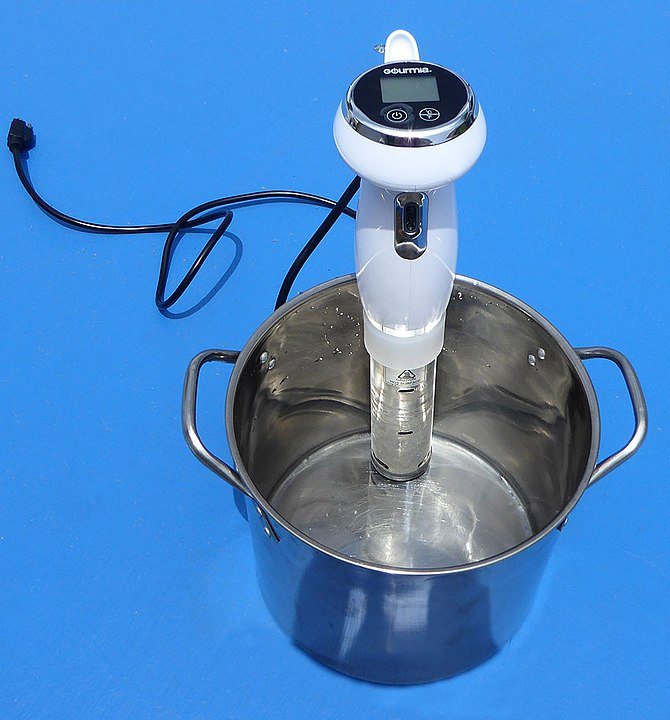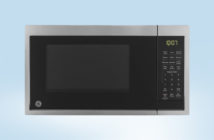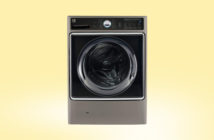Cooking, for most people, is usually hit or miss. Especially for beginners, kitchen adventures are guesswork, where a few seconds on the pan is the difference between undercooked or overcooked.
There are many spoiled dinners and lots of wasted food. But of course, there are ways to determine if your meal is done. The sound of the oil, the color of the meal or vegetable, or the firmness can all be clues to whether you should remove it from the pan.
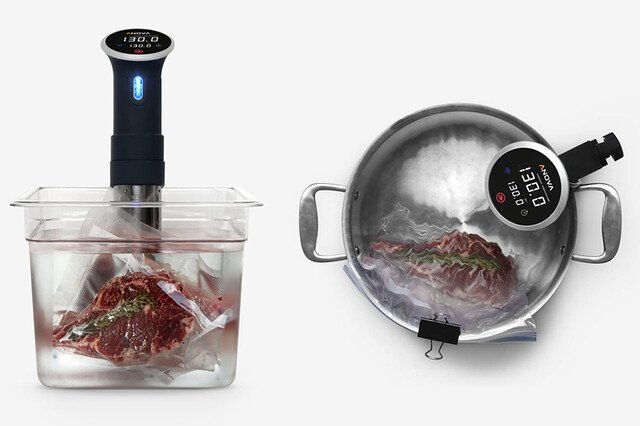
By sousvideguy (Creative Commons Attribution-Share Alike 2.0 licence)
However, most of these things rely on experience. Beginners (and even some veterans) will still find the insides of their meals undercooked.
But what if you could remove the need for guesswork and intuition? What if you could enjoy a way to cook that’s precise and accurate, giving you the same results every single time?
Contents
What is Sous Vide Cooking?
For a long time, people have been trying to create a method of achieving just that.
Sous vide cooking is a combination of three different cooking techniques: low-temperature cooking, containerized cooking, and vacuum-sealing the food.
Low temperatures allow the food to be cooked more evenly throughout. Containerizing and vacuum-sealing food allow for better flavors. Combined, these techniques created food that’s often more flavorful, as well as perfect for the dinner table every time.
In practice, the combination of these techniques meant that food was vacuum-sealed in a bag, then put in a machine that boiled the food at a controlled temperature. The machine would continually assess the temperature of the water and heat it up as necessary.
Understandably, appliances made for sous vide cooking were very expensive. For a long time, only restaurants and professional chefs could afford sous vide cookers.
It’s only very recently that the average home kitchen could afford these machines. Of course, they are still a little pricey, but we’ve come a long way from the $400 price tags.
Sous Vide Cookers
Nowadays, it’s easy to have a sous vide cooker for your own kitchen.
There are two kinds you can choose from:
Immersion
The first is immersion-type sous vide cookers. These are usually shaped like stick-blenders, designed to be clipped to the side of a container filled with water and the food you want to cook.
These cookers will determine the temperature of the water, siphoning it up inside its compartment when necessary and spitting the water back out to maintain the temperature.

By Anova Culinary (Creative Commons Attribution-Share Alike 2.0 licence)
Countertop
The second type of sous vide cooker is the countertop cooker. These cookers are a combination of the immersion-type cooker and a container.
Simply load it with water and the food you want to cook, and then turn on the machine. These are often more flexible than immersion-types and can do more than just sous vide cooking.
In practice, which should you buy? Let’s break down some of the leading brands on the market, and which one is right for you.
Joule By ChefSteps
ChefSteps has always been a pioneer in smart cooking, and they have created their own sous vide machine.
One of the most notable differences between the Joule and other sous vide machines is the size. The Joule is almost half the size of typical models.
And it’s not just sleek; the Joule is also very durable, as it’s made with extruded polycarbonate and stainless steel. It’s also unobtrusive, as its magnetic base sticks to your pot without the need for clamps.
Because of its sleek body, you may think that the Joule is less powerful than other sous vide cookers. In fact, the Joule is very powerful and can boil water much faster than other models.
Joule is also Bluetooth and Wi-Fi compatible, meaning you can easily control the pace and status of your meal with just the push of a button.
Unfortunately, Joule’s design also makes this a downside. Everything can be controlled with your phone, but there is no other way for you to manage your cooker.
While its design is sleek, it doesn’t leave room for temperature displays and the like, which can be a deal-breaker for some people.
On the other hand, you can still use your Joule without having to bring your phone around. Simply connect your Joule to your Amazon Alexa or Facebook Messenger. Of course, if you don’t mind having to use smart tech in the kitchen, the Joule is the ideal cooker for you.
Anova Sous Vide Precision Cooker
The Anova Sous Vide cooker is one of the most popular sous-vide machines in the market. Of all the favored models, the Anova is the most flexible.
Like many smart cookers, the Anova can be controlled via Bluetooth, allowing you to cook and track your meals with your phone.
On top of that, the Anova can also be controlled using a built-in display with an LED-backlit scroll wheel. In this way, you can control your Anova from both your phone and the machine itself.
The biggest downside with the Anova is that not all models have Wi-Fi connectivity. The models that come with Wi-Fi are slightly pricier than those without. For some people, however, a Bluetooth connection is more than enough.
Of course, you can always use the built-in displays to control your cooking ventures, although that may feel like it defeats the purpose of a smart cooker.
Compared to the Joule, the Anova is a much clunkier model. Rather than a magnetic base, the Anova clips to the sides of your pot as it works.
While this makes for a considerably less sleek design, some people may prefer this over a less reliable magnetic base.
Gourmia GSV 150
For those who want the greatest range of features for their investment, this model has your back. The Gourmia GSV 140 is perhaps one of the best deals on the market.
Despite its relatively low price, the Gourmia packs a whopping 1200 watts, which is a lot of power for a meager cost. On top of that, the Gourmia can also work with a container that can hold up to five gallons of water and circulate 1.5 gallons of water per minute. Talk about powerful!
The Gourmia is an improvement on their previous GSV140 model. The most obvious change is its design. The Gourmia has an LED display and control panel, but it is angled down for ease of use.
Another notable feature is its clip; unlike other designs on the market, the Gourmia clips from the front instead of the sides or bottom. In this way, you can read the display while attaching the Gourmia to your pot.
It also means that, as you’re cooking, you don’t have the pot between you and your Gourmia; you can easily read the display at any time.
This video shows what the Joule sous vide looks like out of the box.
Sous Vide Recipes
If you’ve already picked out your new sous vide cooker, why not try your hand at some recipes?
Of course, not everything is better off when cooked sous vide. However, ingredients that are best suited to sous vide cooking, like sous vide steak and chicken, are simply marvelous.
Here are some recipes to get you started!
Chicken Teriyaki Bowl
A chicken breast is notoriously hard to cook on a stovetop—sous vide chicken breast, however, is something else entirely.
This recipe brings the savory and sweet flavors of teriyaki with the unparalleled tenderness of sous vide cooked meats.
With a side of sous vide eggs, this recipe is not only balanced; it’s very healthy as well. This recipe for teriyaki chicken comes from Anova Culinary, but it can be used with any model.
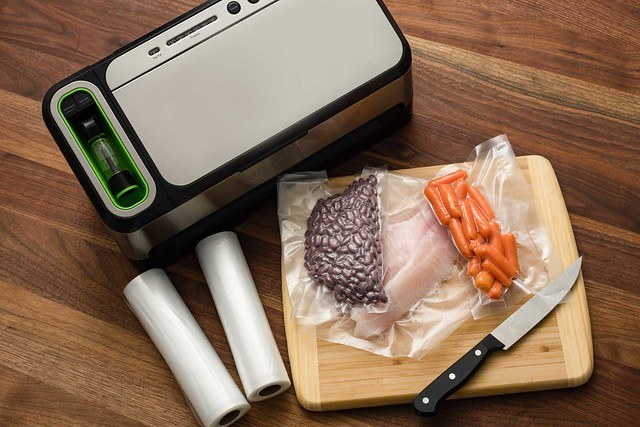
By YourBestDigs (Creative Commons Attribution-Share Alike 2.0 licence)
Ingredients
Creates four servings
- 4 medium-sized chicken thighs or breasts.
- 4 tablespoons of soy sauce.
- 4 tablespoons of sake.
- 2 tablespoons of rice wine vinegar.
- 1 tablespoon of brown sugar.
- Black pepper.
- 1 teaspoon of ginger, minced.
- 1 teaspoon of garlic, minced.
- ¼ teaspoon of chili powder (optional).
- 1 tablespoon of cornflour.
- 1 tablespoon of water.
- 4 eggs.
- 2 cups of white rice.
Pickled Vegetables
- 1 pound and 4 ounces of veggies, finely sliced.
- 1 cup of water.
- 1 cup of vinegar.
- 1 tablespoon of salt.
- 2 tablespoons of brown sugar.
Method
- Preheat your water bath to 146 degrees Fahrenheit.
- While your water bath is boiling, prepare your marinade. Place soy sauce, sake, rice wine vinegar, brown sugar, black pepper, ginger, garlic, and chili powder in a bowl. Stir to combine.
- Place your chicken in the bowl to coat it in the marinade.
- Then, transfer the chicken to your ziplock bag. Add in the rest of the marinade.
- Drop the bag into the water bath.
- Place the eggs inside the water bath. You don’t need a bag for these.
- Leave eggs and chicken in the bath for 50 minutes. While cooking the eggs and chicken, prepare the rice and vegetables.
- Place all pickling ingredients with the vegetables in a pot over high heat. Bring it to a boil, then remove from heat. Cover the pot and set aside to allow it to pickle.
- While waiting for your chicken and eggs, cook your rice.
- When the chicken and eggs are done, remove them from the water bath. Set the eggs aside. Separate the chicken and marinade, putting the marinade into a bowl.
- In a separate bowl, mix cornflour and water until it reaches a thick consistency. Pour this into the marinade and mix to create a sauce.
- Pat the chicken dry with paper towels and lightly season with salt.
- Heat a skillet over medium heat. Fry the chicken on each side for about two minutes. Add in the sauce at the last minute of cooking, and toss over the chicken to coat it.
- Now, remove the chicken from the sauce. Season the sauce to taste. Continue to cook the sauce until it reaches the consistency you want.
- Now it’s time to assemble your bowl! Drain the pickled vegetables and slice the chicken. Add white rice to the bowl. Serve the chicken over the rice, and put the vegetables to one side. Crack the egg on top of your ingredients, and season with salt and pepper.
Pork Tenderloin with Rosemary Garlic Maple Glaze, Apple Onion Hash
Another great recipe to make with a sous vide is a pork tenderloin.
After all, a sous vide is basically a slow cooker that doesn’t dry out your food—and what better recipe to cook with it than pork tenderloins?
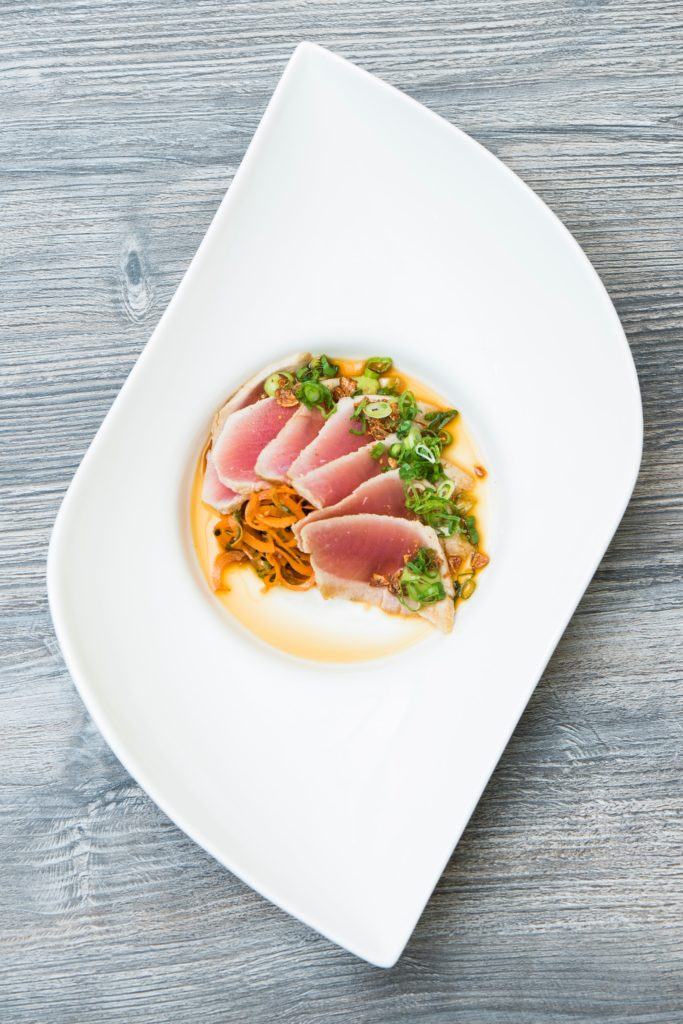
Ingredients
Creates two servings.
- 1 piece, 1-pound pork tenderloin.
- ½ apple, cut into small cubes.
- ½ large onion, diced.
- 1 teaspoon of butter.
Rosemary Garlic Maple Glaze
- 3 large sprigs of rosemary.
- 2 garlic cloves, mashed into a paste.
- ¼ cup of olive oil.
- 1 tablespoon of maple syrup.
- Salt.
Method
- Preheat your sous vide machine to 135 degrees Fahrenheit.
- Mix all glaze ingredients (rosemary, cloves, olive oil, and maple syrup, along with a large pinch of salt) in a food processor.
- Set aside about 1/3 of this mixture. Use the remaining mixture to rub all over the pork loin. Add some salt to taste.
- Vacuum seal the pork loin and place in the water bath. Cook for two and a half hours.
- When the pork is done, heat a nonstick skillet with butter until sizzling. Add the pork and sear, cooking all sides at around 45 to 60 seconds each. Remove the pork and set aside, but do not remove the pan from the flame.
- Add your apples, onions, and a teaspoon of the remaining glaze onto the pan. Sautee ingredients over medium heat, until onions are slightly translucent and the apples have softened.
- Slice the pork into pieces. Spoon the leftover glaze on top. Serve with a scoop of apples and onions. Salt to taste.
This video goes into more detail on sous vide recipe.
Sous vide cookers can truly open new doors to cooking, whether you’re a beginner or a seasoned expert.
Hopefully, this has helped your search for the right sous vide cooker, and perhaps even helped you cook a recipe or two with your new kitchen tool!
Have you tried cooking using the sous vide method?

